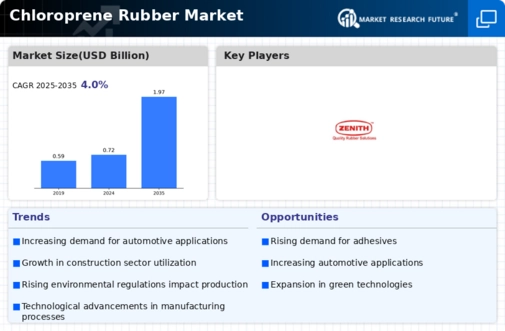Chloroprene Rubber Size
Chloroprene Rubber Market Growth Projections and Opportunities
The Chloroprene Rubber Market is influenced by a variety of factors that shape its growth and dynamics:
Automotive Industry Demand: The automotive industry is a significant driver of demand for chloroprene rubber due to its use in manufacturing various automotive components such as hoses, belts, seals, and gaskets. As the automotive sector experiences fluctuations in production levels and consumer demand, it directly impacts the demand for chloroprene rubber in the market.
Construction Sector Growth: The construction industry is another major consumer of chloroprene rubber, utilizing it in applications such as adhesives, sealants, and roofing materials. Growth in construction activities, driven by infrastructure development, residential construction, and commercial projects, drives the demand for chloroprene rubber in the market.
Consumer Goods Manufacturing: Chloroprene rubber finds extensive use in the manufacturing of consumer goods such as footwear, sporting goods, and industrial products due to its elasticity, durability, and weather resistance. Changes in consumer preferences, trends in fashion, and the demand for high-performance products influence the demand for chloroprene rubber in the market.
Industrial Applications: Chloroprene rubber is widely used in various industrial applications such as conveyor belts, hoses, and industrial machinery parts due to its resistance to oils, chemicals, and abrasion. The industrial sector's demand for durable and resilient materials drives the demand for chloroprene rubber in the market.
Technological Advancements: Advancements in manufacturing processes and formulations contribute to the growth of the chloroprene rubber market by improving product performance, reducing production costs, and expanding application possibilities. Manufacturers invest in research and development to innovate and introduce new chloroprene rubber grades tailored to specific industry needs, driving market growth.
Regulatory Environment: Regulatory standards and compliance requirements related to product safety, environmental impact, and chemical management influence the chloroprene rubber market. Manufacturers must ensure that their products meet regulatory standards regarding toxicity, emissions, and workplace safety, shaping market dynamics and product offerings.
Raw Material Availability and Pricing: The availability and pricing of raw materials such as chloroprene monomer directly impact the chloroprene rubber market. Fluctuations in raw material prices, supply chain disruptions, and geopolitical factors can affect production costs and product pricing, influencing market dynamics and profitability.
Global Economic Conditions: Global economic factors such as GDP growth, industrial output, inflation rates, and currency fluctuations influence the chloroprene rubber market. Economic downturns can lead to reduced consumer spending, investment, and industrial activity, impacting demand for chloroprene rubber and market dynamics.
Environmental Sustainability Initiatives: Increasing awareness of environmental issues and sustainability drives demand for eco-friendly materials and processes in various industries. Chloroprene rubber manufacturers are responding to these trends by developing sustainable production methods, reducing emissions, and offering bio-based alternatives, influencing market dynamics and consumer preferences.
Trade Policies and Tariffs: Trade policies, tariffs, and trade agreements between countries affect the import and export of chloroprene rubber and its feedstocks, shaping market dynamics and competition. Changes in trade regulations, tariffs, or trade disputes can disrupt supply chains, affect pricing, and influence market access for chloroprene rubber manufacturers.





Leave a Comment